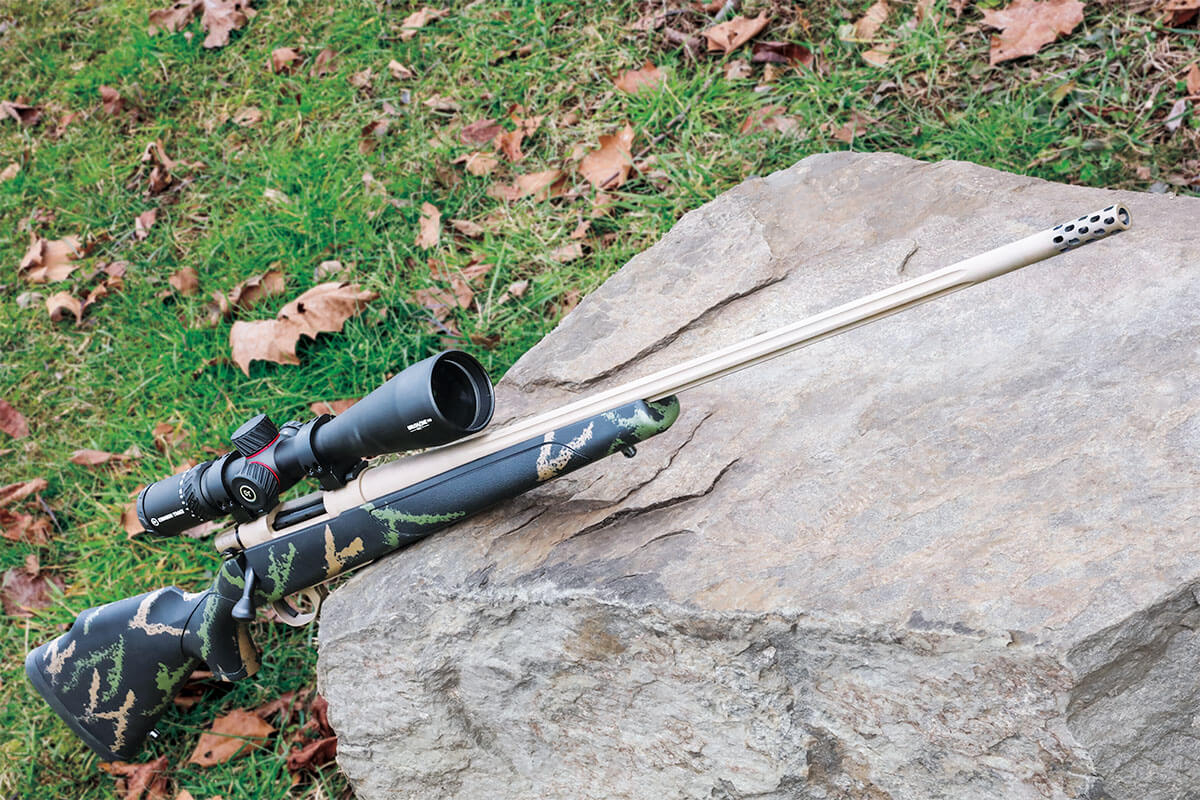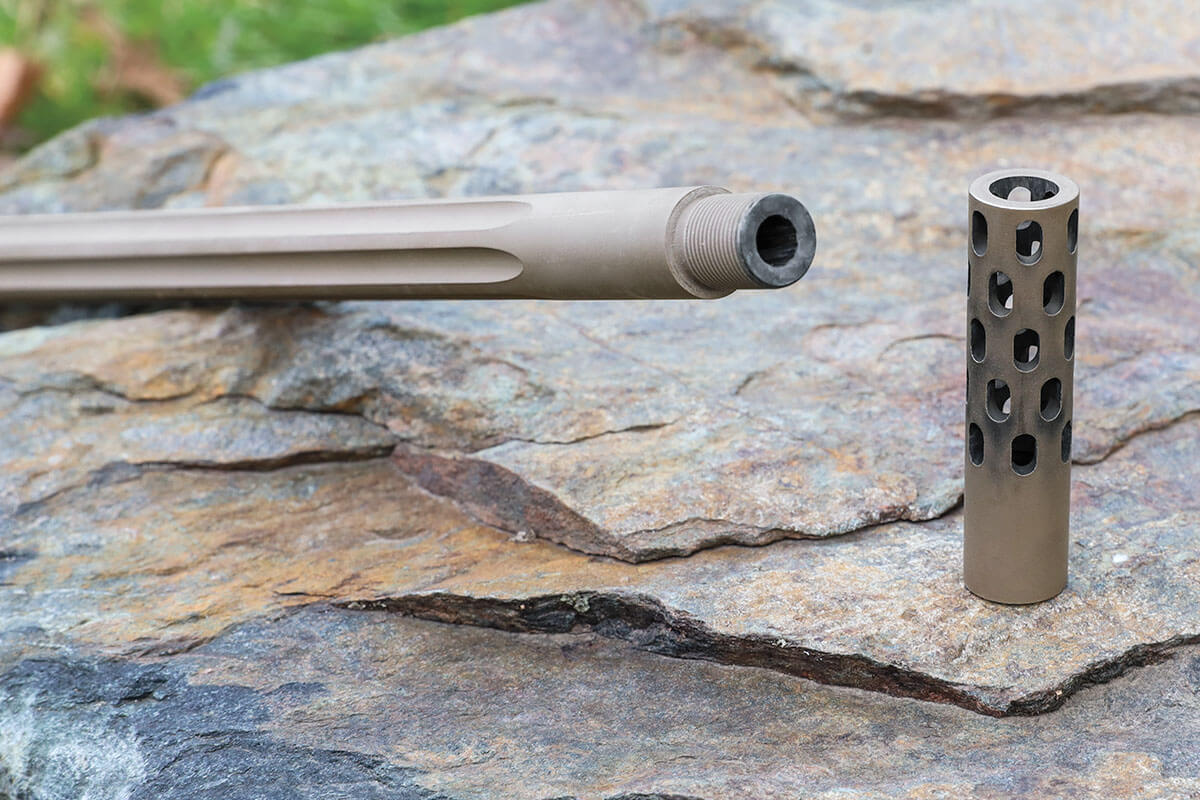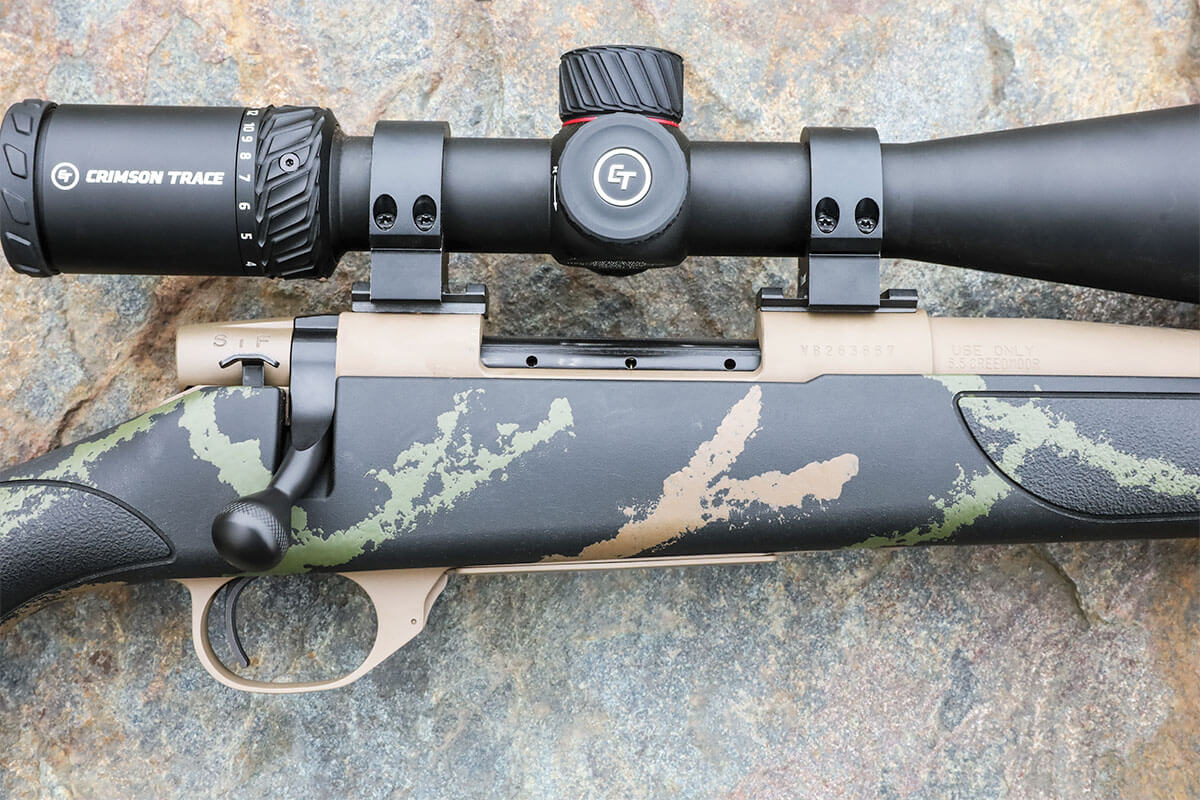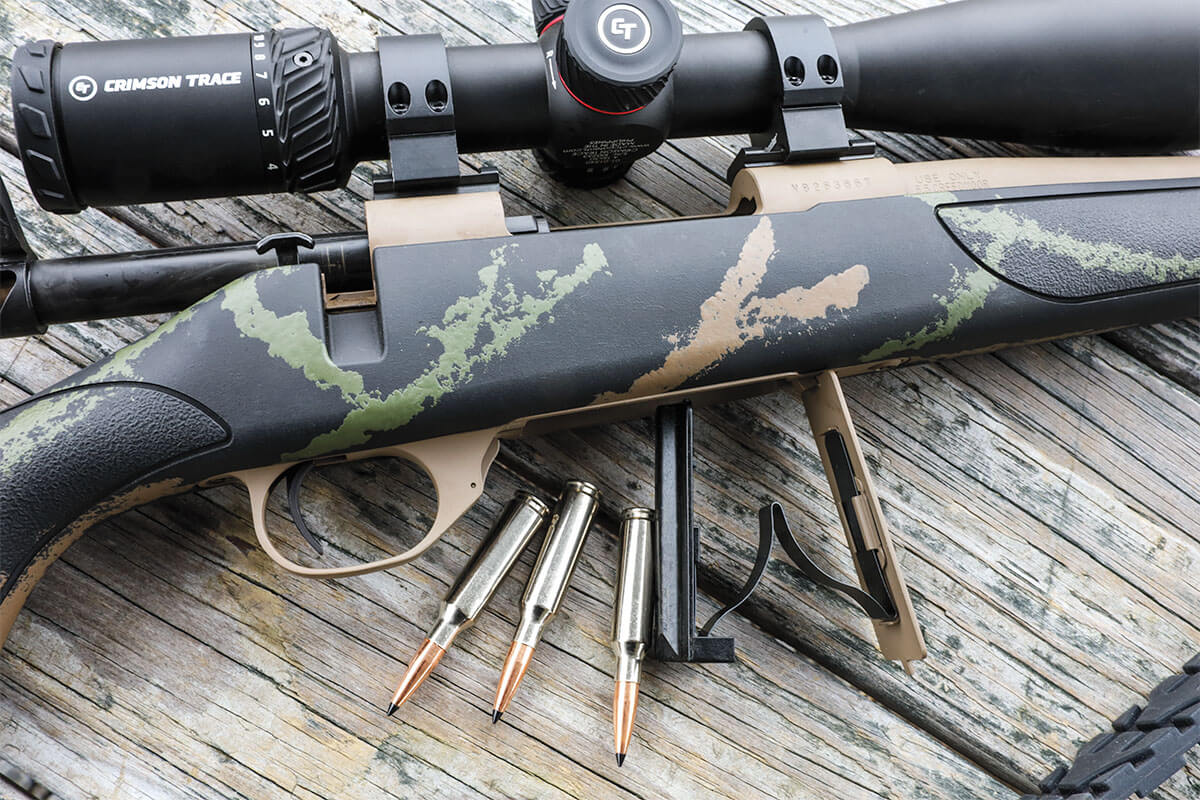
Roy Weatherby was a visionary in the firearms industry. From his early experiments with ultra-velocity rounds to the development of his supremely safe action and his early adoption of polymer stocks, Weatherby was always at the leading edge of hunting rifle innovation. He was also a brilliant marketer. I still recall the images of a tree blown into so many matchsticks by a single .300 Wby. round and Roy palling around with famous actors like John Wayne and Roy Rogers.
Dressed in fancy Monte Carlo stocks and chambered for hard-hitting magnums, the Weatherby Mark V became the “it” hunting rifle of the mid-20th century. But all that fancy walnut came at a price, one many hunters simply couldn’t afford.
Roy Weatherby understood the need for a workingman’s Mark V, and in 1970 the company announced the Vanguard. Vanguard rifles were—and are—built on Japanese Howa push-feed actions. At the time of their inception, they rivaled popular rifles like the Remington 700 and Winchester Model 70, and Vanguard guns remain a popular option for big game hunters.

Recently, the bolt-action rifle market has been flooded with inexpensive, sometimes coarsely built, budget rifles that provide good accuracy but lackluster aesthetics. But Vanguard rifles have always been a step above those basic entry-level guns, combining solid construction with modern good looks at a price that the working hunter can afford.
As of this writing, there are 19 different Vanguard models currently available, ranging from .22-250 to .375 H&H Mag. There are Vanguards for smaller-statured shooters on up to rifles meant for dangerous game. There are Vanguards with wood stocks and synthetic stocks and package deals that include a Leupold 3-9x40mm scope. Suggested retail prices range from the mid-$500 mark up to $1,149.
“While originally launched in only a few configurations, the Weatherby Vanguard now boasts value-added features such as Cerakoting, barrel fluting, custom stock painting, barrel threading and custom floorplates,” said Adam Weatherby, Roy’s grandson and Weatherby’s current CEO. “Although the barreled action is still manufactured in Japan, these new features are all applied at our new facility in Sheridan, Wyoming.”
Over the years I’ve tested or hunted with seven different Vanguard models and have been impressed with every one of them. Vanguard rifles feature sub-m.o.a. accuracy and are backed with an accuracy guarantee—one of the first rifles at this price point to offer such a guarantee. A Vanguard Backcountry in .257 Wby. Mag. I once tested produced average groups around a half-inch with two different Weatherby loads, and I regret not buying that gun when I had the chance.

The newest member of the Vanguard family is the High Country model. As the name suggests, the High Country is designed to be light enough to carry on big game hunts at high elevations where the oxygen is thin and every ounce of rifle weight is a burden. The High Country I tested in 6.5 Creedmoor weighed just 7.15 pounds with its 24-inch fluted barrel.
The cold-hammer-forged barrel is finished in flat dark earth Cerakote for corrosion resistance, and it’s threaded 1/2×28. It comes with Weatherby’s Accubrake ST muzzle brake, which adds two inches to the barrel, as well as a seamless thread protector. The barreled action is free-floated and incorporates an integral recoil lug.
The synthetic stock features Weatherby’s trademark Monte Carlo comb. It’s black with green and tan sponge-paint accents, and the stock is equipped with textured grip panels and a right-hand palm swell. I’m a fan of the grip angle, which puts my shooting hand in the correct position.
High Country rifles are available in nine chamberings—five standard rounds and four magnums. Standard cartridges, including the 6.5 PRC, have 24-inch barrels while magnum chamberings sport 26-inch barrels and weigh a couple ounces more. The Vanguard High Country rifle carries a suggested retail price of $949, which places it in competition with Browning’s X-Bolt Composite Stalker ($910) and Bergara’s B-14 Wilderness Ridge ($975).
All Vanguard guns share the same push-feed bolt action with a small claw extractor and plunger ejector. Like the Mark V, the Vanguard rifles come with three gas ports in the one-piece machined bolt, as well as a fully enclosed bolt shroud, to help prevent injury in the event of a case failure. The bolt body is fluted to shave weight.

The Vanguard High Country is easy to top-load through the generous ejection port. Unlike some bolt-action hunting rifles that are finicky about loading and feeding, the Vanguard isn’t. A floorplate release is recessed into the front of the trigger guard. The release on my gun was a bit tight, but that’s not a bad thing, as the odds of an inadvertent mag dump are exceedingly low.
All current Vanguard rifles are equipped with a two-stage trigger. That has resulted in some shooters mistakenly calling Vanguard triggers “creepy,” but the take-up is intentional and acts as a safety mechanism without employing a blade. Initial take-up is smooth and light, and after that it it requires minimal finger pressure to drop the sear.
Weatherby Vanguard triggers average between two and four pounds, and they are user adjustable. The one on my sample averaged 3.4 pounds for 10 pulls on a Wheeler gauge.
The three-position safety is the rocker-type design and is easy to manipulate. In the rearward position the trigger is deactivated and the bolt is locked. In the middle position the bolt can be manipulated with the safety engaged. Pressing the safety rocker forward allows the gun to be fired.
I like three-position safeties because the bolt can be locked when walking so that brush and limbs don’t inadvertently open the action and the rifle can be loaded and unloaded with the safety engaged. Weatherby safeties can also be manipulated silently so if you suddenly find yourself close to game, the metallic “snick” of the rifle’s safety won’t catch the animal’s attention.
The bolt stop is located on the left rear side of the receiver, and it’s easy to operate. A small cocking indicator tab that extends under the rear bolt shroud lets you know the gun’s condition.

The High Country is drilled and tapped to accept Weatherby Vanguard/Remington 700 bases, which simplifies scope mounting. I topped the High Country with a Crimson Trace 4-16×42 Brushline Pro riflescope with BDC reticle. The Monte Carlo stock placed my eye in correct position behind the optic.
4-16×42 Brushline Pro: Check Price & Buy Now
I tested the High Country at the range with three different 6.5 Creedmoor loads. All three produced at least one three-shot group under an inch at 100 yards, and the best group of the day measured just 0.44 inch. A tack-driver, in other words, and well in line with the rifle’s guarantee for sub-m.o.a. accuracy.
The 6.5 Creedmoor produces mild recoil, which is one of its benefits, but having the removable Accubrake ST is a nice touch—and will be very much appreciated on the .300 Wby. Mag. version of the gun. This relatively new brake from Weatherby promises recoil reduction of up to 53 percent. All Vanguard rifles handle recoil well, and the dense black Vanguard recoil pad does a good job of absorbing kick.
In addition to range testing, I also got to use the Vanguard while hunting hogs and deer at a field-to-table event in Texas, and the High Country had no issues gathering meat. My first shot came when an old, heavy whitetail buck followed a group of does out of the oaks during late afternoon. A doe at the edge of the oaks caught the old buck’s attention, and he trotted away from the harem into the cover of the trees.
At any moment the buck might disappear from view, and since it’s difficult to have a field-to-table event without meat, I decided to try to make a shot on the deer before he vanished into the deep woods. There was a narrow window between two oak trunks through which I would have to weave the bullet, but I had confidence in the High Country rifle and took the shot. The buck was quartering away, and after the rifle cracked, I heard the thwop of the 129-grain Hornady bullet. The buck dropped.

The next shot came the following morning when I spooked a group of hogs at a feeder. My guide Ray and I had crept into a position on a hill overlooking the feeders and the hogs scattered. Because we wanted a pig for the table, I chose a small sow, and as she ran through the broken brush I led her by a half-body length and touched off the Weatherby. The same distinct bullet slap echoed up the canyon, and we found the hog 30 yards from where she had been when the bullet struck her shoulder.
The modern crop of affordable sub-m.o.a. hunting rifles means more challengers for Weatherby’s Vanguard guns. But the Vanguard has something that few of its competitors can boast about: five decades of experience redefining the affordable bolt-action hunting rifle segment.
“My grandfather first introduced the Vanguard as a lower-cost alternative to the Mark V rifle,” Adam Weatherby said. “From its hammer-forged barrel to consistent tight tolerances and an accuracy guarantee, it grew to become a wildly successful project that is now its 50th year of existence.”
There are guns less expensive than the Vanguard, and a few of them carry an accuracy guarantee that matches Weatherby’s. But very, very few guns offer the combination of high build quality, consistent accuracy and bang-for-your-buck value that Vanguard rifles promise. That was the case five decades ago when this model made its debut, and it remains so today.
Weatherby Vanguard High Country Rifle Specifications
- Type: bolt-action centerfire
- Caliber: .257 Wby. Mag., 6.5 Creedmoor (tested), 6.5 PRC, 6.5-300 Wby. Mag., .270 Win, .308 Win., .30-06, .300 Win. Mag., .300 Wby. Mag.
- Capacity: 4+1
- Barrel: 24 in.; threaded 1/2×28; Accubrake ST muzzle brake
- Overall Length: 46 in.
- Weight: 7 lb., 3 oz.
- Stock: black synthetic with tan/green sponge paint
- Finish: flat dark earth Cerakote
- Trigger: 3.4 lb. pull (measured)
- Sights: none; drilled and tapped
- Price: $949
- Manufacturer: Weatherby, weatherby.com








































![Air gun 101: The differences between .177 & .22 – Which jobs they do best ? [Infographic]](https://airgunmaniac.b-cdn.net/wp-content/uploads/2024/11/1773-150x150.jpeg)


